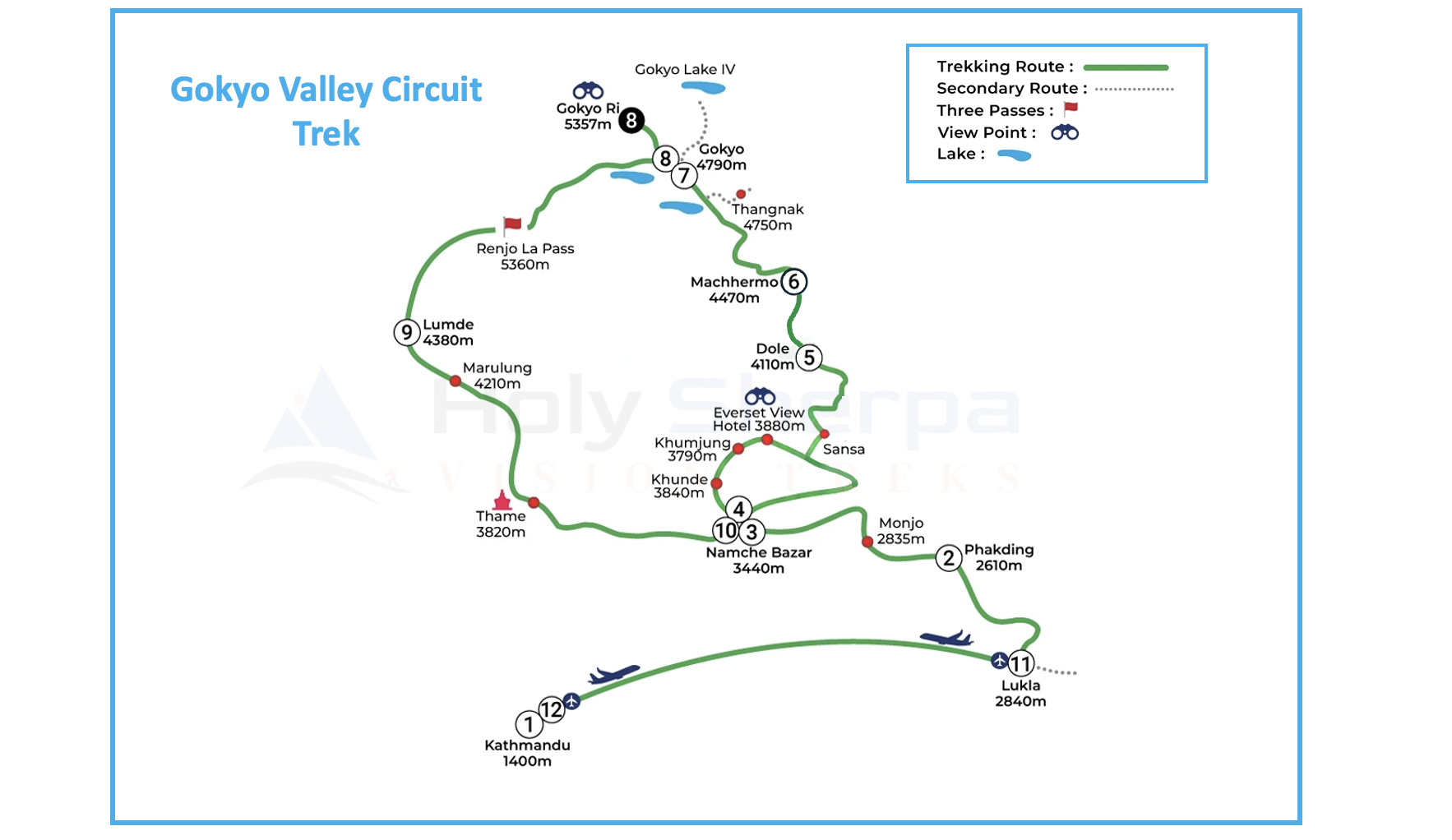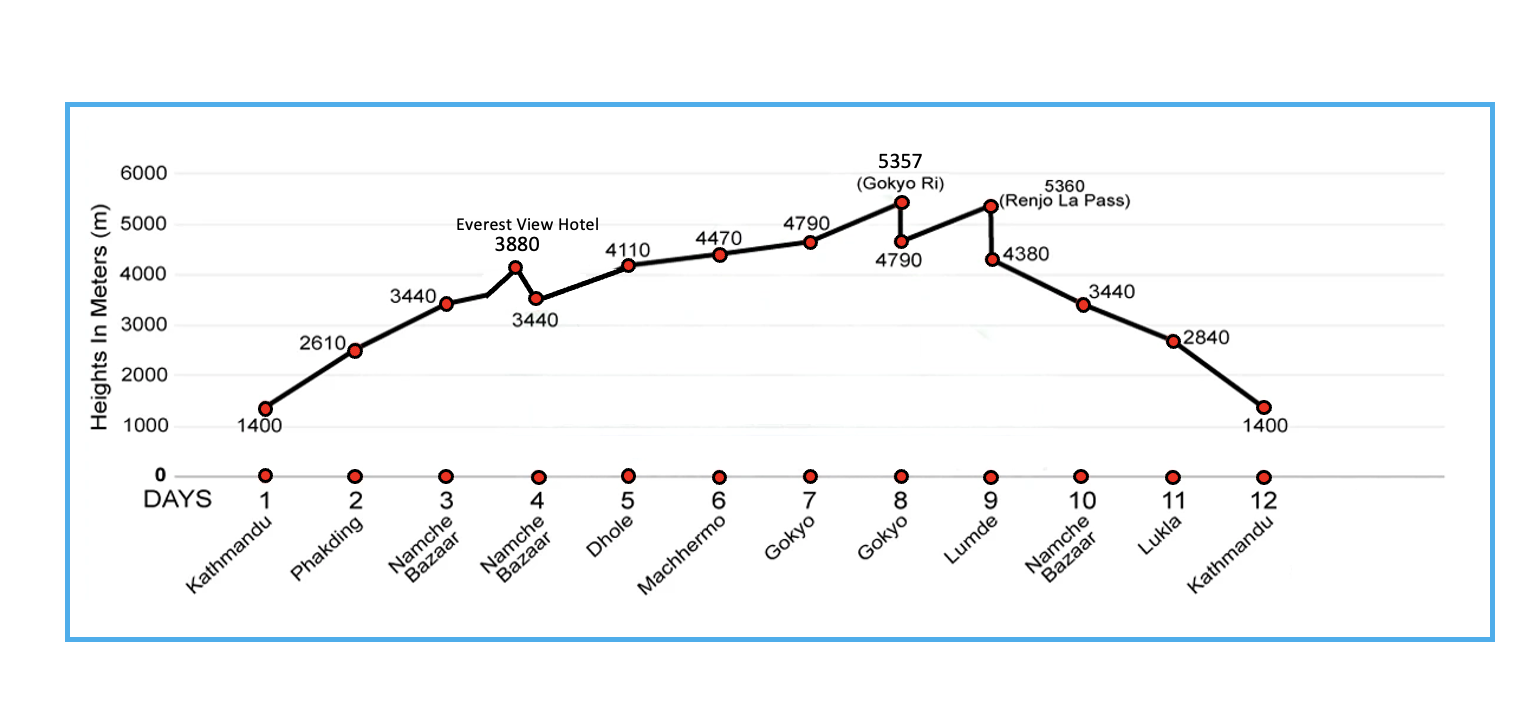Gokyo Trek: The Lakeside Jewel of the Everest Region
The Gokyo Trek is a breathtaking alternative to the classic Everest Base Camp trek, leading you through pristine valleys, sparkling turquoise lakes, and towering Himalayan peaks. Located in the Khumbu region of Nepal, this trek is famous for the Gokyo Lakes, a chain of high-altitude glacial lakes that are both sacred and spectacular.
The Beauty of Gokyo
Unlike the crowded Everest Base Camp trail, the Gokyo trek offers peaceful trails, unique landscapes, and equally dramatic mountain views. The highlight is Gokyo Ri (5,357m), a vantage point that rivals Kalapatthar. From its summit, trekkers can see four of the world’s tallest peaks, Everest, Lhotse, Makalu, and Cho Oyu, all in one frame.
The shimmering Gokyo Lakes (4,700m–5,000m) reflect the snowcapped mountains like a mirror, creating one of the most magical alpine settings in Nepal. These lakes are considered holy by both Hindus and Buddhists, adding a spiritual dimension to the trek.
Gokyo Ri: A Himalayan Panorama
The jewel of the trek is Gokyo Ri (5,357m), a vantage point that offers one of the best panoramic views in Nepal. From its summit, you can see four of the world’s tallest mountains in one frame:
1. Mount Everest (8,848m)
2. Lhotse (8,516m)
3. Makalu (8,463m)
4. Cho Oyu (8,188m)
The beauty of the trek reaches its pinnacle at Gokyo Ri (5,357m). From this viewpoint, trekkers are gifted with one of the most majestic panoramas in Nepal: Everest, Lhotse, Makalu, and Cho Oyu standing tall together, their snow crowns glittering in the sunlight. Few places in the world allow you to see four 8,000-meter giants in a single gaze.
Adding to its charm is the Ngozumpa Glacier, the longest glacier in Nepal, stretching across the valley like a frozen river of time. The contrast between icy ridges, turquoise lakes, and rugged peaks makes the Gokyo Valley a place of stunning natural contrasts.
What makes the Gokyo trek truly beautiful is not only the landscapes but also the silence and serenity it offers. The trails are quieter than Everest Base Camp, allowing trekkers to soak in the scenery without distraction. The prayer flags fluttering in the wind, the peaceful Sherpa villages, and the crystal-clear Himalayan skies together create a setting where nature and spirit meet in harmony.
The Gokyo Trek is more than just a trek, it is a living canvas of lakes, mountains, glaciers, and skies. Its beauty lies in its ability to leave you speechless, reminding you that some places in the world are meant not only to be seen, but to be felt deep within the soul.
Highlights of the Gokyo Trek
Upon arrival at Tribhuvan International Airport, you will be greeted and transferred to your hotel. The rest of the day is free to rest, recover from your journey, or explore the lively streets of Thamel.
Take a scenic mountain flight to Lukla, the gateway to the Everest region. After meeting your trekking crew, begin a gentle hike along the Dudh Koshi River to Phakding. The walk is relatively easy and helps you adjust gradually to the altitude.
Cross suspension bridges, pass through pine forests, and enjoy your first glimpses of Everest and Kusum Kanguru. The trail ascends steeply before reaching Namche Bazaar, the vibrant Sherpa capital, where you’ll spend the night.
A rest day for acclimatization. Explore Namche, visit the Sherpa Museum, or take a short hike to Everest View Hotel for panoramic views of Everest, Lhotse, and Ama Dablam. Proper acclimatization is essential for a safe trek.
Leave the busy Everest Base Camp route and ascend through rhododendron and birch forests towards Dhole. Fewer trekkers follow this path, making it quieter and more peaceful.
Continue along high-altitude trails with stunning mountain vistas. Today’s walk is moderate and short, giving you enough time to rest and prepare for higher altitudes ahead.
Trek through alpine landscapes and climb steadily until you reach the breathtaking Gokyo Lakes. These turquoise glacial lakes are considered sacred and offer some of the best scenery in the region.
Spend the day exploring Gokyo. Hike up Gokyo Ri (5,357m) for one of the finest panoramic views of Everest, Cho Oyu, Makalu, and Lhotse. Rest and enjoy the beauty of the lakes before crossing Renjo La the next day.
This is one of the highlights of the trek. Cross the Renjo La Pass (5,360m), offering magnificent views of Everest and the surrounding peaks. Descend along a less-traveled trail to Lumde.
Descend through yak pastures and traditional Sherpa villages, passing through Thame, the hometown of famous Sherpa climbers. Continue to Namche Bazaar for an overnight stay.
Retrace your steps along the Dudh Koshi River back to Lukla. This is the final trekking day, where you can celebrate your achievement with your trekking crew.
Take a scenic morning flight back to Kathmandu. After checking in at your hotel, enjoy a relaxing day or explore the city further.
Your unforgettable journey comes to an end today. You will be transferred to Tribhuvan International Airport for your flight home or to your next destination, taking with you memories of the majestic Himalayas and the adventures of the trek.
Airport pick-up from Tribhuvan International Airport (arrival date & time)
Flight ticket from Kathmandu to Lukla
Three meals a day (breakfast, lunch, dinner) during the trek
Accommodation during the trek
All necessary Gokyo Trek permits
Experienced English-speaking guide (including meals, accommodation, transport, salary, insurance & equipment)
Flight ticket from Lukla to Kathmandu
Farewell dinner at a Nepali restaurant in Thamel before departure
Airport drop-off (departure date & time)
International airfare to/from Nepal
Nepal entry visa fee
Travel insurance covering emergency evacuation and medical expenses
Extra hotel nights in Kathmandu in case of early arrival or late departure
Personal refreshment expenses (soft drinks, hard drinks, bottled water, cigarettes, chocolates, etc.)
Utility expenses (telephone, electricity for charging, internet/Wi-Fi, laundry, etc.)
Tips for trekking support crew


Basic Information about the Gokyo Trek
1. Location:
The Gokyo Trek is located in the Everest region of Nepal, within Sagarmatha National Park, a UNESCO World Heritage Site, famous for its dramatic Himalayan landscapes and Sherpa culture.
2. Difficulty Level:
Classified as moderate to challenging due to high altitude. Trekkers should be physically fit and allow proper time for acclimatization to avoid altitude sickness.
3. Maximum Altitude:
The trek’s highlight is Gokyo Ri (5,357m), a viewpoint that offers panoramic views of Everest, Lhotse, Makalu, and Cho Oyu.
4. Permits Required:
Foreign trekkers need the Sagarmatha National Park Entry Permit and the Khumbu Pasang Lhamu Rural Municipality Permit, both easily available in Kathmandu or along the trail.
5. Best Season:
The ideal times are spring (March–May) and autumn (September–November), when the weather is stable, skies are clear, and mountain views are at their best.
6. Accommodation:
Accommodation is provided in local teahouses and lodges offering basic rooms and meals such as dal bhat, noodles, soups, and Tibetan bread.
7. Connectivity:
Mobile networks and paid WiFi services are available in some villages, but connectivity becomes weaker at higher altitudes.
9. Cultural Experience:
The trek offers a deep insight into Sherpa culture, with visits to monasteries, prayer flags, and the spiritually significant Gokyo Lakes, which are considered sacred.
Free cancellation
No Deposit Required